Revlon (1945-1960)
Continued from: Revlon
Continued onto: Revlon (post 1960)
Revlon increased its sales and widened its distribution network during the Second World War but scarce supplies meant that growth was restricted. Even so, by 1947, the company had become the world’s largest vendor of nail enamel and lipstick (AP&EOR, 1947), a measure of the size of the American cosmetics market.
Nail enamel
In 1946, Revlon updated the formula for its nail enamel and repackaged it as Lastron in a bottle with a long, lucite-handled brush which the company said made applying the polish easier.
Lastron Nail Enamel: “[G]oes on like a breeze . . . dries in split seconds . . . ends smearing, peeling, chipping worries! Wear? With a charmed life! Beautiful bottle! Exclusive lucite plume balances your hand, makes you expert at applying enamel. Comes in all Revlon shades.”

Above: 1946 Bachelor’s Carnation with older nail enamel bottle.
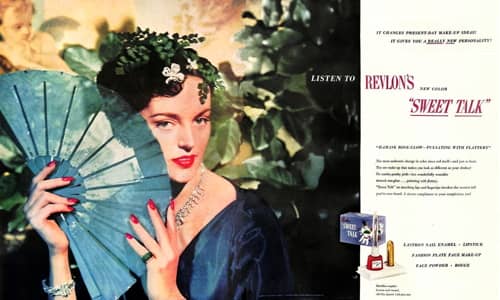
Above: 1948 Sweet Talk with Lastron in the new nail enamel bottle.
In 1947, Revlon also added Everon, a new base coat, unfortunately made with phenyl-formaldehyde resins which proved to be potent allergy sensitisers. Perhaps because of this, Revlon replace Everon with Prolife in 1948, before adding a top coat, Supersealer, in 1950.
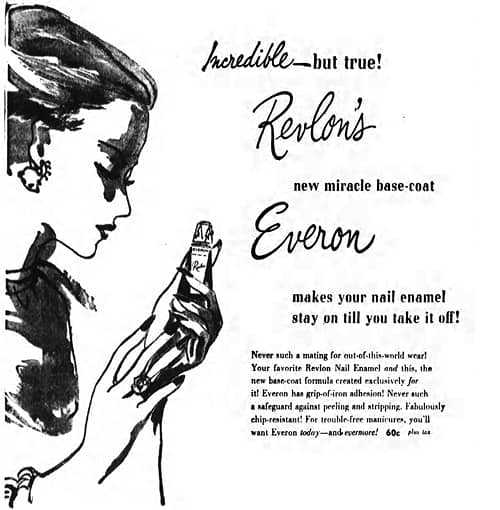
Above: 1947 Revlon Everon Base Coat.
In 1952, Revlon combined Supersealer with Prolife to begin the Nail Builder range. The first Nail Builder Sets came in two forms: Normal, consisting of Prolife base coat and Supersealer top coat; and Problem, made up of a specially-formulated base coat for problem nails called Frosted Prolife and Supersealer. In 1953, Revlon then added two more products to the Nail Builder range: Nail Builder Creamy Cuticle Remover and Nail Builder Cuticle Massage Cream.
Nail Builder Creamy Cuticle Remover: “New easy way to keep your cuticle soft and smooth. Special double-performance action—a precious lubricant soothes and softens cuticle, while at the same time ‘remover action’ loosens and removes dead cuticle.”
Nail Builder Cuticle Massage Cream: “A rich new cream fortified with white iodine precious Cholesterol and soothing Lanolite—Revlon’s exclusive skin-softening ingredient! For dry, brittle or splitting nails.”
Other base coats added through the decade included Super-Base (1954), and Wonder Base (1958). New top coats
Super-Base: “There’s never been a basecoat like it! Flows on like liquid glass, dries almost as rapidly as applied, and nail enamel just glides on over it. You'll be astounded how much longer your nail enamel stays on.”
Wonder Base: “Creamy in texture, … potects your nails as it protects your nail enamel . . . helps end chipping to make manicures last days and days longer!”
Lipstick
In 1947, Revlon also reformulated its lipstick as ‘All Plus’ formula and returned to producing them in ‘Good-as-Gold’ metal containers. In 1949, Revlon began calling its lipsticks ‘Luscious’ even though they were generally promoted as an indelible.
In November, 1947, like a number of other companies, Revlon introduced a longer pencil lipstick also using the ‘All Plus’ formulation. Revlon’s version, called Lip Fashion, had a double-angled tip – a narrow edge for outlining the lips and a broad surface for making the fill in strokes. It was as advertised as ‘A longer lipstick—Not a lipliner’.
All-Plus Lipstick: “Just what the name implies . . . in its rich silken texture; easy stroke-on, prolonged lip beauty.”
Luscious Lipstick: “[S]tays on longer than any lipstick we’ve ever seen.”
Lip Fashion: “It’s the famous luscious Revlon lipstick in the easy-in-handle, longer, gold-colored metal case! Balances in the hand to give you new expertness and sureness in ‘putting on’ your mouth!” Shades included: Ultra Violet, Pink Lightning, Pink Garter, Fatal Apple, Quiet Pink, Bachelor’s Carnation, Raven Red, Rosy Future, Windsor, Snow Rose, Snow Pink, Chilibean, and Certainly Red.
In 1949, the company combined Lip Fashion with a ball-point pen to produce Fashion-Write, a ‘lipstick-pen’ that would apply lipstick at one end and write notes at the other. Another novelty added in 1950 wa the Lip-Mirror. It came in two forms: a thick version for Lustrous Lipsticks and a thinner style for Lip Fashion.
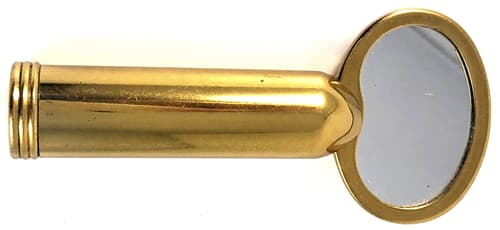
Above: Revlon Lip-Mirror. This is the thicker version for Luscious Lipsticks. Attaching the mirror to the end of the lipstick when not is use meant it was less likely to get lost in a purse or handbag.
Shade ranges
Revlon was known for its extensive shade range and the company continued to use full-color photographic advertisements in major magazines to publicise new shades with spreads occasionally running over two pages. New postwar shades included: Fatal Apple (1945); Tortoise Shell, Hildegarde Rose, Ultraviolet, and Bachelor’s Carnation (1946); Cinderella’s Pumpkin, Quiet Pink, and Certainly Red (1947); Sweet Talk, and Orchids to You (1948); Plumb Beautiful, Ripe Pimento, and Touch of Genius (1949).

Above: 1945 Revlon Fatal Apple.
Revlon later added: Sunny Side Up, Stormy Pink, and Where’s the Fire? (1950); Baby Tangerine, Lilac Champagne, Orange Sherbert, Paint the Town Pink, Love that Red, and Certainly Red (1951); Say it with Roses, Fire and Ice, and Paint the Town Pink (1952); Crazy Pink, Cherries in the Snow (1953); Cinnamon Stick, Queen of Diamonds, and Kissing Pink (1954); Hot Coral, Cherries a la Mode, and Love that Pink (1955); Pink Vanilla (1956); Orange Flip, Pink Heaven, Red Caviar, Mocha Polka, and Persian Melon (1957); Say it with Rubies, Butterfly Pink, and Fifth Avenue Red (1958); Gold Frosted, White a la Carte, Nougat, Frosted Pink, Honey Vanilla, Strawberry Vanilla, Coral Vanilla, Mango Sherbet, Tangerine Sherbet, Orange Float, Toffee Sherbet, Raspberry Icing, Violet Icing, Grape Icing, Flama Grande, Cherry Mousse, and Pink’issimo (1959); and French Toast, and Cherry Bon Bon (1960).
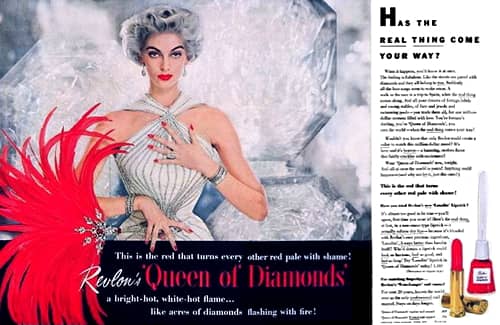
Above: 1954 Queen of Diamonds.

Above: 1955 Cherries a la Mode.
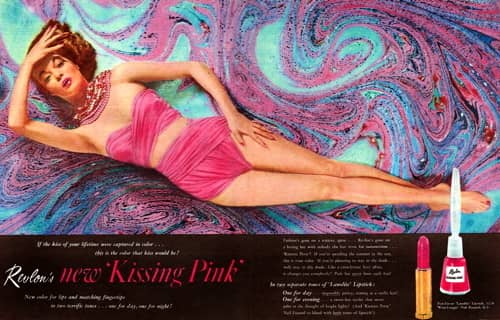
Above: 1955 Kissing Pink.
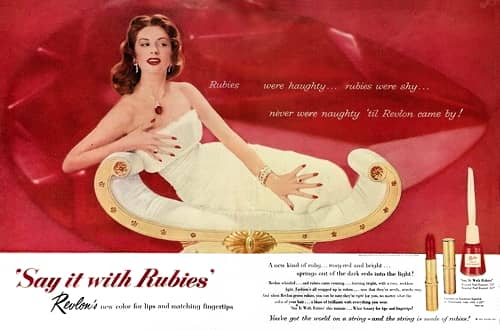
Above: 1956 Say it with Rubies.
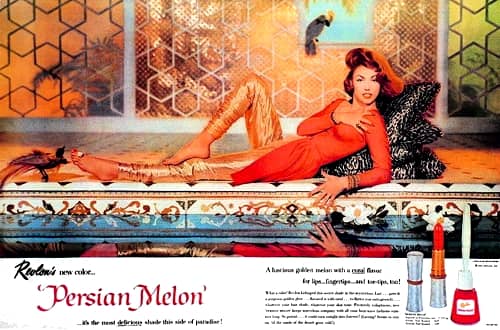
Above: 1957 Persian Melon.
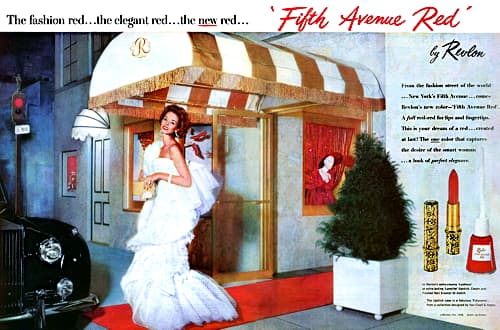
Above: 1958 Fifth Avenue Red.
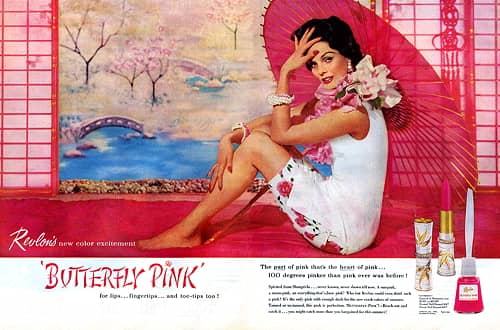
Above: 1958 Butterfly Pink.
In 1959, Revlon began introducing new shades in color collections starting with Colors Unlimited (Pastel Look) Lipsticks (Strawberry Vanilla, Nougat, Orange Float, Frosted Pink, Toffee Sherbet, Mango Sherbet, Violet Icing, Coral Vanilla, Raspberry Icing, Tangerine Sherbet, Grape Icing, Honey Vanilla and White a la Carte) with matching nail enamels (Strawberry Vanilla, Honey Vanilla, Coral Vanilla, Mango Sherbet, Violet Icing, Toffee Sherbet and Raspberry Icing) and frosted shades (Cherry Mousse, Pink Platinum, Apricot Ice, Candied Peach, Orange Parfait and Pink Julep) added later.
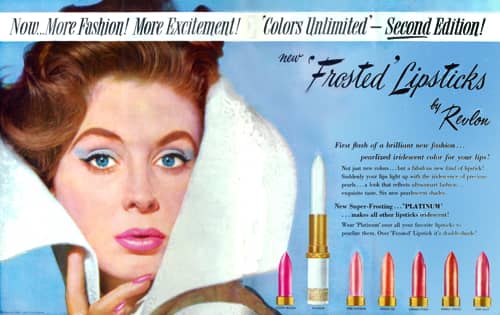
Above: 1959 Colors Unlimited Second Edition.
Revlon also added Bon Bons (Frosted) Nail Enamels (Violet Creme, Champagne Taffy, Pistachio Mint, Butter Pecan, Pineapple Yum Yum, Pink Coconut, Platinum, and Sugar Blue) in the same year.
Revlon put a great deal of effort into promoting its new shades the most successful campaign being Fire and Ice which launched in the autumn of 1952.
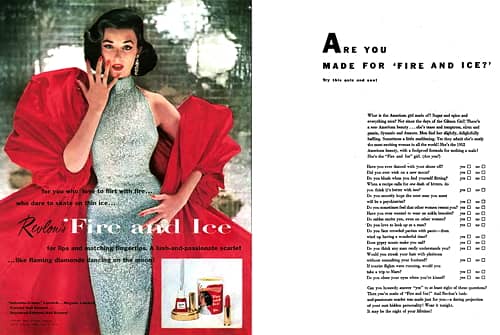
Above: 1952 Fire and Ice. The dress front was covered in rhinestones mostly sewn on by a man who did costumes for strippers. It did not have a back and was held in place with safety pins. The scarlet cape was a copy of one by Cristóbal Balenciaga [1895-1972] that Kay Daley had seen in Paris (Tobias, 1976). The lipstick was available in Indelible-Creme and Regular formulations with the Regular and Frosted Nail Enamels made to an ‘Improved formulation’.
The Fire and Ice shade campaign was developed by Kay Daley, from the advertising agency Norman, Craig & Kummel, and Beatrice (Bea) Castle, Revlon’s in-house marketing executive. The campaign featured the model Dorian Leigh [1917-2008] in a silver, sequinned dress with red cape photographed by Richard Avedon [1923-2004]. ‘Vogue’ magazine planned its November issue around the shade, and a blanket of magazine ads, window displays, counter cards and radio endorsements, and a good deal of free publicity, pushed total Revlon sales to almost US$25.5 million.
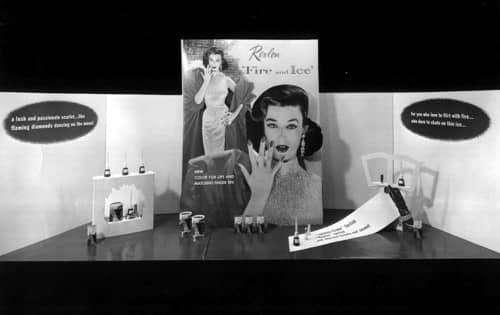
1952 Revlon Fire and Ice window display.
New products
Other additions to Revlon’s product range in the immediate post-war period included: Fashion Plate (1947), a pressed cream powder that promised a ‘poreless-as-porcelain’ finish; Aquamarine Lotion (1947), a hand and body lotion; and Touch and Glow (1950), a liquid make-up with a matt finish.
Fashion Plate: “A boon to women with skin imperfections because it gives complete coverage without creating an artificial ‘made up’ look. Apply with the fingertips and blend with a damp sponge. Gives a smooth, natural finish” Shades: Ultra Violet, Pink Lightning, Sheer Dynamite, Tortoise Shell, Bachelor’s Carnation, Fatal Apple, Mrs. Miniver Rose, Rosy Future, Russian Sable, Country Cream, and Natural with Cinderella’s Pumpkin added later that year.
Aquamarine Lotion: “[L]ooks—and feels—and is—the height of luxury. Change to this first real hand complexion treatment tomorrow! Richly concentrated, so little goes so far.”
Touch-and-Glow: “Dry skin looks dewy; dull skin glows with young color. Look closely . . . your complexion never bloomed like this! And how artfully this liquid make-up hides lines and shadows—without maskiness! Nobody knows you wear it . . . but you! Never caky or drying.” Shades: Natural, Light, Creamy Ivory, Misty Rose, Cream Beige, Rachel, Suntan, and Dark Dark.
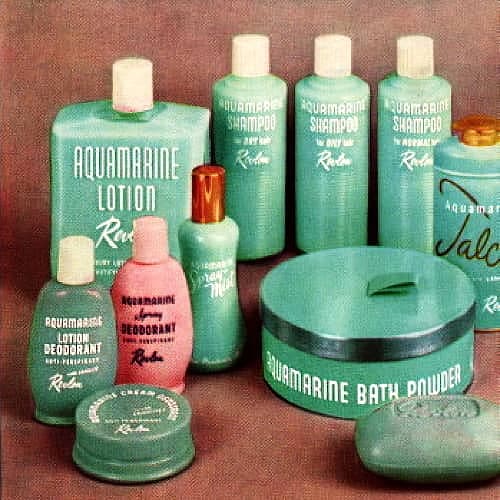
1956 Aquamarine range.
When Aquamarine Lotion proved to be successful, Revlon built it into a complete line which included: Aquamarine Lotion Soap, Aquamarine Bath Powder, Aquamarine Cream Deodorant, and Aquamarine Lotion Deodorant (1950); Aquamarine Spray Deodorant (1951); Aquamarine Shaving Balm, Aquamarine Lotion for hands and legs, and Aquamarine Lotion Shampoo, for dry, normal, oily and bleached hair (1952); Aquamarine Talc (1953); Aquamarine Splurge, after-bath mist (1954); and Aquamarine After Bath Freshener, and Aquamarine Milk Bath (1959).
This practice of adding ‘flankers’ or ‘line extensions’ was repeated by Revlon to build a number of products into extended lines including Ultima, Moon Drops, Natural Wonder, Clear and Clear, and Sun Bath.
By 1950, Revlon was a large cosmetics company with manufacturing plants in North and South America, in 11 countries in the Near and Middle East, and subsidiary organisations in 11 European countries as well as Britain, Iceland and Malta (AP&EOR, 1950). Overseas sales were handled by Revlon International Corporation, the renamed Revlon Export Corporation, which established branches in a number of countries around the world.
In the United States, the company’s products were distributed directly to 1,700 department stores, 5,700 better drug stores and numerous high class beauty salons (AP&EOR, 1951) and Revlon could be said to be on par with its competitors. However, apart from nail polish/enamel Revlon did not dominate any particular line of cosmetics and, although it was a market leader in lipsticks, its commanding position in this category would soon be challenged.
The lipstick wars
In 1950, Hazel Bishop began an extensive newspaper, radio and television campaign promoting Hazel Bishop Lasting Lipstick beginning what has been referred to as the American ‘Lipstick Wars’. By 1953, Hazel Bishop had captured 25% of the American lipstick market and had added a rouge and nail enamel.
See also: Hazel Bishop and Lipstick Wars
Most of Hazel Bishops’s success was due to its extensive use of television advertising, a medium Charles Revson did not understand and disparaged, mainly because it was broadcast in black-and-white, not colour.
Just as color plays a major role in Revlon products, so it does in advertising. Each new color is promoted to the hilt. Magazine ads, counter cards, packages, window displays and direct mail proclaim the new colors as they come along. Color is one reason that Revlon has never gone heavily into radio or black-and-white television. But when color television is perfected, you can bet your bottom dollar Revlon will be in it.
(AP&EOR, 1951, p. 116)
The situation was made worse for Revlon when Coty launched Coty “24” indelible lipstick in 1955 using the theme ‘Wake up beautiful with “alive” color glowing on your lips!’. It proved to be a big seller and affected Revlon’s sales even further. Between Hazel Bishop and Coty, Revlon’s share of the American lipstick market hit an all time low (Abrams, 1977, p. 128).

Above: 1951 Revlon Indelible-Creme Lipstick in Pink Lightning, Bachelor’s Carnation, Sweet Talk, Love that Red, Plumb Beautiful, Certainly Red, Scarlet Poppy, Touch of Genius, Pink Plumb Beautiful, Stormy Pink, Snow Pink, Bravo, and Ripe Pimento shades.
In 1951, to combat Hazel Bishop, Revlon added Indelible-Creme Lipstick to its Regular Lipstick but was forced to abandoned it in 1953 when the U.S. Federal Trade Commission (FTC) got agreement from advertisers that lipsticks can only claim to be ‘indelible’, ‘smear-proof’, or ‘non-smear’ if the word ‘type’ was used with such descriptions. Its replacement was Lanolite Lipstick (1954), a greasy, lanolin-enriched lipstick, in non-smear and regular formulations; however, sales were disappointing.
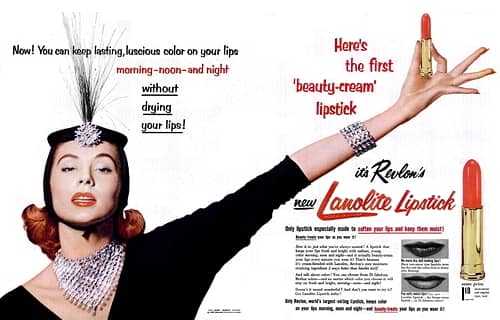
Above: 1955 Revlon Lanolite Lipstick in 33 shades.
Lanolite Non-Smear Type: “[A] revolutionaty new non-smear type lipstick that really lasts . . . without leaving the lips parched and dry.”
Lanolite Regular: “[S]oft, super creamy, utterly wonderful feeling on the lips. Amazing stay-on quality.”
In 1955, in response to Coty “24”, Revlon introduced Living Lipstick (the twenty-four hour type) with the line ‘Put living color on your lips’ an obvious copy of Coty’s ‘alive’. This meant that when Revlon introduced its Futurama refillable lipstick cases – designed by the jewellers Van Cleef & Arpels – later in the year, they could be filled with either Living, Lanolite Non-Smear or Lanolite Regular lipsticks.
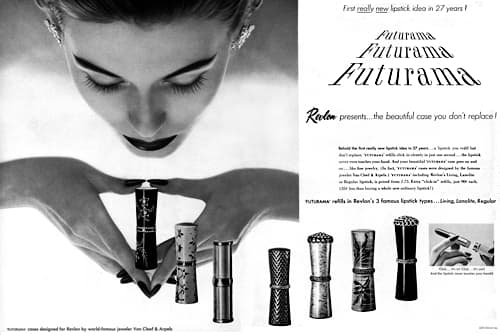
Above: 1956 Revlon Futurama. It is possible the Charles Revson picked this name as it had been previously used by General Motors to name their exhibition in the 1939 New York World’s Fair. Revson wanted to be the General Motors of cosmetics.
In 1956, the company added Lustrous Lipstick – the fourth lipstick Revlon had marketed since 1951. Women could now choose between Revlon’s Living, Lanolite Non-Smear, Lanolite Regular, or Lustrous lipsticks. The choice confused them and Revlon got trade complaints from retailers about the need to stock four different types of lipstick in a wide range of colours and refills. Realising there was a problem, Abrams states that Revson decided to concentrate on Living Lipstick and dumped over 1,000,000 Lanolite lipsticks off the Revlon inventory (Abrams, 1977, p. 129). It is possible that only Lanolite Non-Smear lipsticks were dumped as the company was still selling Lanolite lipsticks in the 1960s along with Lustrous and Super Lustrous II.
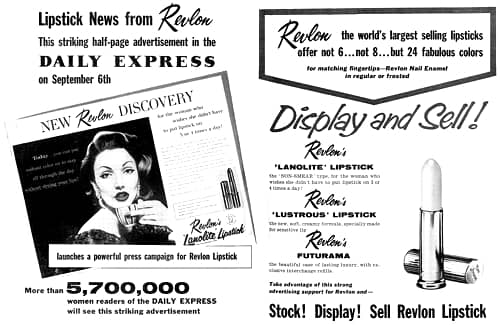
Above: 1957 British trade advertisement for Lanolite and Lustrous Lipsticks, and Futurama cases.
Meanwhile, Coty had informed International Playtex – who had a trademark on ‘Living’ (for Living Bras) that included toiletries – about Revlon’s use of the ‘Living’ name and Revlon was forced to cease production of this line under threat of court action. This may have been the lipstick that Abrams suggested Revlon dumped from its inventory. Fortunately, Revlon was now in a position to bear the cost of all these changes. By 1956, it had become the sole advertiser on the hottest television show in America, ‘The $64,000 Question’. With it Revlon won the lipstick wars and Coty and Hazel Bishop were no longer considered a major threat.
‘The $64,000 Question’
Revlon had previously sponsored a number of television shows including ‘Revlon Mirror Theater’, ‘Mr. and Mrs. North’, ‘What’s Going On?’ and ‘Whom Do You Trust?’ none of which had proved to be successful in its battle with Hazel Bishop and their television program ‘This is Your Life’. Revson had little choice but to try again and much against his better judgement he agreed to be come the sole sponsor of yet another television program, ‘The $64,000 Question’.
The show first went to air on 7th June, 1955 and, after a slow start, proved to be a phenomenon. Almost anything Revlon advertised on it got a massive sales boost. The company’s sales jumped from US$33,604,000 to US$51,646,000 in 1955 – even though the program had only been televised for six months – and had more than doubled to US$110,363,000 by 1958, the year the show went off the air (Abrams, 1977, p. 64).
See also: Revlon and ‘The $64,000 Question’
By 1960, Revlon was the number one seller of lipstick, hairspray, nail products and make-up (Tobias, 1976, p. 148) and way out in front of all of its competitors, even outselling Avon. Revlon had also gone public on December 7, 1955, six months after the debut of ‘The $64,000 Question’. The shares began at US$12 but hit US$30 within a few weeks and were split two-for-one in 1956. Helena Rubinstein may have been a rival but even she had Revlon shares.
However, Charles Revson was soon on his own. Joseph Revson left the firm in 1954 and Martin followed in 1958. In both cases the departures were acrimonious.
Other lines
During the 1950s Revlon expanded its product range in a number of directions, adding a number of new product categories to its inventory.
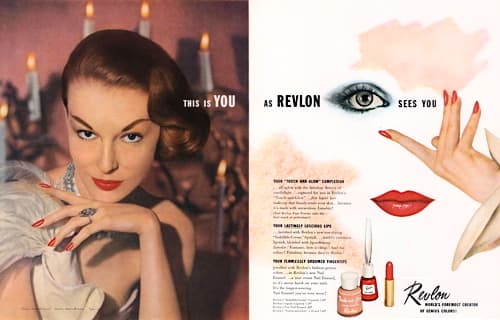
Above: 1952 Revlon Touch-and-Glow, Nail Enamel and Indelible-Creme Lipstick.
Make-up
New additions to Revlon’s make-up range in the 1950s included: Second Nature (1952), an estrogenic fluid make-up; Love-Pat (1953), a pressed powder-cream; Touch-and-Glow Face Powder (1955); and Touch-and-Glow Pressed Powder (1958). The new Touch-and-Glow powders came in the same shades as Touch-and-Glow Liquid Powder introduced in 1950 and were updated accordingly.
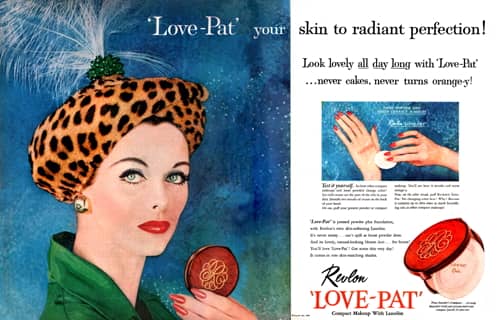
Above: 1956 Revlon Love Pat.
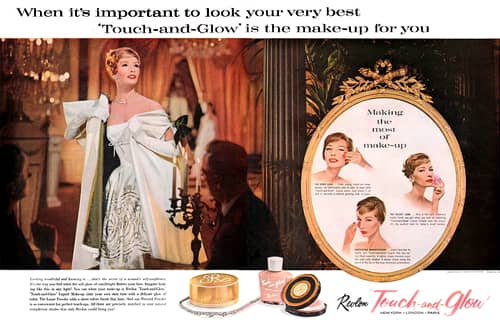
Above: 1959 Revlon Touch-and-Glow Face Powder, Liquid Make-up, and Pressed Powder.
Second Nature: “If you have mature akin you need than a make-up foundation. You need the day-long, Youthifying benefits of hormones. Revlon gives you both In Second Nature . . . the estrogenic fluid make-up. It’s never greasy . . . never drying; equally good for oily or dry skins.” Shades: Light, Creamy Ivory, Misty Rose, Dark Dark, Creamy Beige, Rachel, Sun Tan, and Natural (colorless).
Love-Pat: “A special blend of pressed powder and foundation with skin-softening Lanolite.” Shades: Cream Beige, Cream Ivory, Dark Rachel, Sun Tan, Light, Light Light, Misty Rose, and Rachel.
Touch-and-Glow Face Powder: “Blended with Lanolite, it clings for hours, gives your skin luminous glow!” Shades: Natural, Light, Creamy Ivory, Misty Rose, Cream Beige, Rachel, Suntan, and Dark Dark.
In 1950, Revlon also filled a major gap in its make-up range with the addition of Dreamy Eye Make-up – Mascara, Eye Shadow and Eyebrow/Eyeliner Pencil.
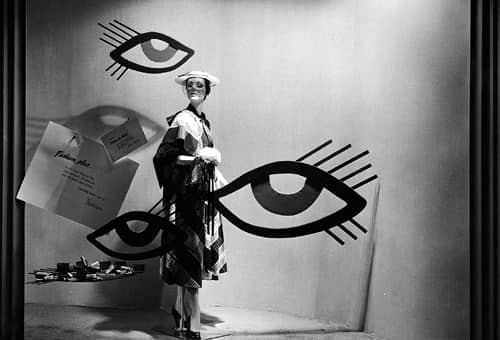
Above: c.1950 Window display for Dreamy Eye Make-up.
The range consisted of a cake mascara in a plastic mock tortoiseshell case in Birchwood, Ebony, Evergreen, Fresh Violet, Ice Blue, Marcasite, Pistachio, Royal Blue, Teal Blue, Titian and Walnut shades; a stick eye-shadow in a gold-toned, lipstick-type case in Blue Frost, Evergreen. Fresh Violet, Gold Frost, Green Frost, Ice Blue, Mauve Frost, Pistachio, Royal Blue, Sea Frost, Silver Frost and Teal Blue shades; and an eyebrow pencil/eyeliner in a plastic tortoiseshell automatic case in Birchwood, Blue Frost, Ebony, Evergreen, Titian and Walnut shades.
See also: Dreamy Eye Make-up (c.1950)
Revlon added additional products to its eye make-up range through the 1950s including Waterproof Cream Mascara (1957) and Roll-On Mascara (1958). The Roll-On Mascara was very similar to Helena Rubinstein’s Mascara-Matic (1957) and came with a groove metal wand rather than a brush but Revlon advertise it as the world’s first auromatic mascara made without turpentine. It came in six shades: Black, Light Brown, Dark Brown, Blue, Dark Blue, and Green.
See also: Automatic Mascara
The success of the Roll-On Mascara – no doubt helped by the ‘The $64,000 Question’ prompted the company to release a more extensive eye make-up range in 1959, Eye Makers à la Carte.
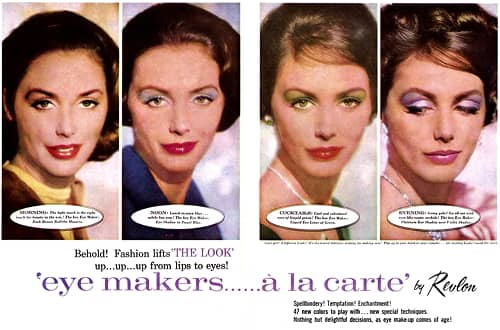
Above: 1959 Revlon Eye Makers à la Carte.
Skin-care
In the 1950s, Revlon developed an extensive skin-care range of ‘Flowing Beauty Cremes’ said to be the ‘ultimate achievement in scientific skin care’.
[A] whole new concept in treatment that’s unique in the history of beauty. Now, with a maximum number of products. Revlon provides all the essentials for skin care (cleansing, stimulation, moisturizing and lubrication) . . . without costly and time-consuming duplications. Each creme contains special youth-giving properties. Each is made in easy flowing liquidform – a truly modern scientific method of skin care that’s totally different from old-fashioned treatment products – that makes them faster acting, deeper penetrating, far more effective and so easy to use [that] even the busiest woman now has time for beauty this streamlined way!
(Revlon’ retail sales training course, c.1955)
Also see: Revlon Retail Sales Training Course (c.1955)
Beginning with White Sable Liquid Cleansing Creme, and White Sable Hormone Liquid Cleansing Creme (1952), Revlon followed this with Moon Drops Moisture Balm (1953), a moisturiser; Build Up (1953), a firming facial; Waking Beauty (1953), a night cream containing vitamins A, D, and E that was made in two formulas, with or without hormones.
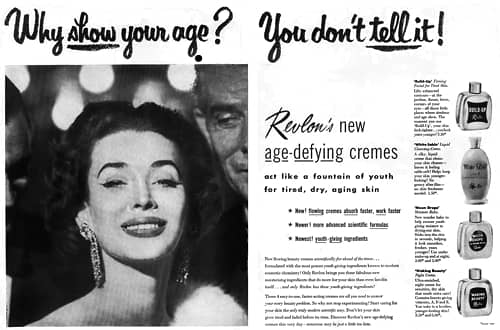
Above: 1954 Revlon Build-Up, White Sable Liquid Cleansing Creme, Moon Drops Moisture Balm, and Waking Beauty.
After this came Clean and Clear (1955), a foaming cleanser; Liquid Asset (1957), a skin normaliser also containing vitamins A, D, and E; Seven Wonders (1957), a night cream for very dry skin containing Lanolite and vitamins A, D, and E; Clean and Clear for Extra Dry Skin (1957); Moon Drops Moisture Foundation (1958); and Ultima (1959), a face cream made with polyunsaturates and squalene.
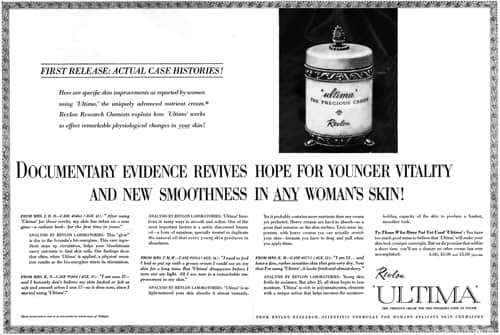
Above: 1959 Revlon Ultima.
White Sable Liquid Cleansing Creme: “[D]ramatically different from old-fashioned cleansers—‘matches’ exactly the normal, healthy acid-alkaline balance of your skin . . . is guaranteed to contain no soap . . . and will not dry out your skin.”
Moon Drops Moisture Balm: “The moment this greaseless flowing cream touches your face, you feel the moisture flow into your skin. And what a delicious sensation it is—like holding your face up to a gentle April rain. ‘Moon-Drops’ literally drenches your skin with moisture that sinks deep into your skin, helping it look smoother, fresher—years younger!”
Moon Drops Moisture Foundation: “Non-greasy foundation that is transparent on the skin, quickly absorbed. Working under make-up it helps protect the skin from losing precious moisture. Also provides a base which helps foundation glide on more smoothly and powder cling longer. Can be used by oily skins for overnight moisturizing.”
Build Up: “[H]elps lift exhausted facial contours—picking up and firming the lines of your face to help you look and feel fresher . . . (and shh—so much younger!)”
Waking Beauty: “[W]akes your skin to a new, firmer, younger look . . . smooths away dryness, tiny wrinkles. VITAMINS A, D and E in ‘Waking Beauty’ let you laugh at wind, sun . . . age and worry lines. Use it . . . you’ll think you’ve turned back the clock.”
Clean and Clear: “[S]cientific deep cleanser in two types—pink greaseless lotion that gently rinses away dirt, grime, makeup; white ‘flowing cream’ for extra dry skin.”
Liquid Asset: “The two layers you see are visual proof of ‘Liquid Asset’s’ unique two-phase formula—a formula which permits maximum absorption of active nutrients and oils—is enriched with vitamins A, D, E. Dry Skin? Oily Skin? ‘Liquid Asset’ normalizes both! It was developed by the Revlon Laboratories to help restore your skin’s chemical balance, bringing both dry (acid) and oily (alkaline) skins back to normal—on contact.”
Seven Wonders: “The cream accomplishes seven tasks—it moisturizes, lubricates, smooths, softens, conditions, tones and stimulates the skin.”
Ultima: “Contains fast-acting polyunsaturates . . . elements that act directly on your skin cells to help increase their moisture holding capacity. This is important because, as you get older, your skin loses its ability to hold moisture … [A]lso contains a specially treated form of squalene much the same as the natural oil your skin had in abundance years back.”
Collectively, these products enabled Revlon to offer ‘scientific’ treatments for a range of skin types all using a four step process – Cleansing, Stimulation, Moisturising, and Lubrication.
SCIENCE HAS FOUND . . .
Science has found that normal, healthy skin has only four basic needs: Cleansing, Stimulation, Moisturising and Lubrication.
CLEANSING
Scrupulous cleanliness is beauty rule number one—but soap and water alone just won’t do. The only way to remove make-up thoroughly is with a liquid cleanser that reaches down deep into the pores and floats out every speck of dust and stale make-up that otherwise would clog the pores.
STIMULATION
Just as our bodies need exercise, so the skin needs stimulation. By increasing the blood circulation, gentle stimulation improves the skin texture, colour tones the skin and keeps your contours firm and youthful.
MOISTURE
Like a plant, the skin needs moisture. Young, healthy skin has its own moisture supply, but central heating, wind and sun all rob the skin of this precious moisture as we grow older. Skin with insufficient moisture looks lined, and needs moisture to restore the look and the softness so often found only in the very young.
LUBRICATION
This is very important because lubrication keeps the surface of the skin soft and supple, and guards against flaking and dryness.(Revlon for a Lovelier You, c.1959, p.4)
See also: Revlon for a Lovelier You (c.1959)
Hair-care
In 1952, Revlon developed Aquamarine Lotion-Shampoo containing the miriacle ingredient ‘Magnetol’. The product came in four different formulas to cater for dry, oily, normal or tinted, and bleached hair. In 1953, it then released Aquamarine Hair Dressing which could be used as a hairdressing or hair conditioner, followed by Silken Net in 1954, described as a ‘perma-soft liquid hair spray’ and Satin-Set ‘a pin-curl spray-set’ in 1955.
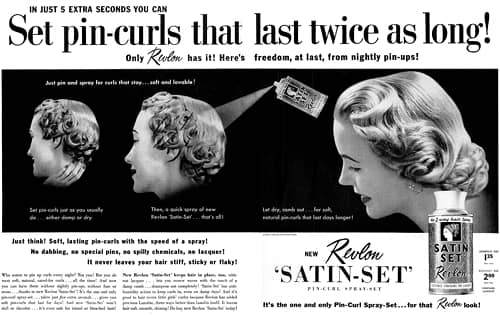
Above: 1955 Satin-Set.
In 1959, Revlon entered the hair-colouring field with its acquisition of Bressard Hair Products Corporation and Bressard Distributors Inc. Bressard made and distributed Tiara hair colouring and hair conditioning products sold to beauty salons for professional use.
Fragrances
Revlon also began to show a greater interest in perfumes. If Charles Revson had not been previously convinced about the importance of fragrance, the success of Estée Lauder’s Youth Dew Bath Oil (1953) must have certainly attracted his attention.
In 1968, making one of his infrequent public appearances as a speech maker, he told the National Association of Chain Store Druggists, “Get a fragrance going and you’ve got everything. Soaps, powders, after-bath colognes, bath beads — you name it!” Revson saw the line extension possibilities of fragrances as a money machine which could keep turning out product after product once the public accepted the basic essence.
He also believed fragrances were one of the few untouchable areas free of government (FDA and FTC) regulation. “Y’know what they’d have to put on a fragrance label?” he told me once. “Hopes and dreams — not ingredients, kiddie — hopes and dreams.”(Abrams, 1977, p. 116)
Revlon released the scent used in the Aquamarine line as a spray mist in 1954, the same year that it debuted Fire and Ice Parfum. In 1955, Revlon then introduced Intimate, a perfume that imitated Miss Dior, first sold in 1947. With some reluctance, Revson agreed to it being advertised on television, the first fragrance to be promoted this way. Within a year it was one of the largest selling fragrances in the world, again helped along by ‘The $64,000 Question’.
In 1959, Revlon took over the American and Canadian distribution of Parfums Revillon of Paris, and purchased Les Parfums Pierre Balmain of Paris in 1960.
Other products
Other products produced by Revlon in the 1950s included: Silicare (1953), a hand protectant; Silicare Medicated Hand and Body Lotion (1955); Sun Bath (1956), a beauty tanning lotion; Hi and Dri (1957), a roll on deodorant (the antibiotic neomycin added in 1960); Living Curl (1958), a hair spray; and Thin Down (1958), tablets for weight reduction containing an appetite depressant and vitamins. Some of these came from Revlon’s increasing interest in pharmaceuticals. The company had established a Pharmaceutical Division in 1955 and some of the pharmaceutical products it produced, such as Silicare were related to skin-care. However, others like Femicin (1958), a medication for period pain, were drugs pure and simple.
Prestige cosmetics
By 1960 – thanks largely to ‘The $64,000 Question’ – Revlon had become one of the biggest cosmetic firms in the United States; only Avon had larger overall sales. Rather than being happy about this, Charles Revson was worried.

Above: 1959 Revlon Christmas suggestions.
Revson knew that there was a difference between a commodity and a fashion item. A commodity was used until it is finished and competitors usually competed on price while a fashion item could be discarded long before the product was used up and competitors differentiated their products through creativity and marketing skill, with a product that was priced accordingly.
As they were primarily about colour, Revson could market nail enamels and lipsticks as fashion items with new colours appearing each spring and autumn. They were advertised extensively and marketed through packaging, displays and promotional tie-ins with fashion magazines and department stores which allowed Revlon to set a premium price. The Publishers Information Bureau indicated that Revlon spent US$396 on magazine advertising in 1935 (a single advertisement in the New Yorker); US$6987 in 1936; US$120,000 in 1941 after lipstick was added to the inventory; and US$492,736 in 1949 (AP&EOR, 1951). Revlon advertised heavily in relation to its sales – and in its early days borrowed heavily to fund it – which gave people the impression that the company was a lot bigger than it really was (Tobias, 1976, p. 108). It also helped establish Revlon as a producer of prestigious products in the minds of its customers.
A key to this strategy was maintaining a degree of exclusivity. To preserve its prestigious image as a high fashion, high-margin brand, Revlon had to control distribution and keep its products out of stores that would cheapen the brand and lead to price competition. For the most part, Revlon had managed to do this, restricting its products to ‘selected’ stores and salons.
Revlon entered the 1950s as a relatively luxurious nail polish and lipstick brand but it ended the decade largely as a mass marketer. This was mainly due to the success of its television advertising but it was also partly the result of the inclusion of new products that were more difficult to promote as fashion items. Revson was very aware of this problem and battled to try and maintain Revlon, or at least parts of the company, as a high-end brand.
The TV campaign had tripled Revlon sales, but it had also made it more mass than class, just the opposite of what Charles Revson had planned. He urged me to retain at least the combination of mass and class, and we had been able to do that through a combination of restricted distribution, luxury packaging and higher than average pricing. Still, there was no denying that the one thing Revlon was losing in the process of growth was “class.”
(Abrams, 1977, p. 190)
Abrams suggests that there was more to Revson’s obsession with class than simple economics.
Revson argued that the quality image of his top lines would enhance the image of basic Revlon. But pride, not profit, was his fundamental motivation in taking the course he did.
(Abrams, 1977, p. 255)
Revson’s concern about prestige was the main reason behind a number of developments that took place in the late 1950s and early 1960s including establishing the Princess Marcella Borghese line (1958) – the first time Revlon had used a ‘celebrity’ endorsement – the opening of ‘The House of Revlon’ beauty salon in New York (1961), and the introduction of the Ultima II line (1964).
Princess Marcella Borghese
After negotiations with Princess Marcella Borghese [1911-2002] in Italy, Princess Marcella Borghese, Inc. was registered as an American corporation in 1957, after which the Princess travelled to the United States to help develop the line. Things did not go smoothly; expected personal formulas for cosmetics proved to be non-existent (Abrams, 1977, p. 196) and, after the line was released in 1958, Fabergé took Revlon to court charging that the Borghese packaging and promotion copied their Julliette Marglen line. These problems may have turned Revson against it and might be part of the reason why Princess Marcella Borghese was not mentioned in company reports until 1965.
Men’s lines
In 1958, Revlon began producing toiletries for men when it introduced That Man Cologne and Top Brass, a medicated men’s hair-dressing used to fight dandruff. That Man may have been a reference to ‘That Nail Man’, a name given to Charles Revson by Helena Rubinstein [1871-1965]. Top Brass was expanded later in 1958 with the addition of Top Brass Deodorant, and Top Brass After-Shave Lotion later in the year, followed by Top Brass Cologne in 1959.
In addition to acquiring a 20% stake in Revlon in Schick, Inc, Revlon then began adding series of men’s colognes, after-shaves, talcs and other toiletries under the Top Brass and That Man as well as Monsieur Balmain (1964), Pub (1965), and Braggi (1966). Many were aimed at specific price points. Pub, for example was positioned between That Man and the upmarket Braggi range.
Diversification
Other issues for Charles Revson were the fickle nature of the cosmetic business and its potential limitations on the growth of the company, both issues made more pressing by the fact that Revlon had become a public company in 1955 and these factors affected its share price.

Above: 1955 New factory space acquired by Revlon from Johnson & Johnson in Edison, New Jersey, to help cope with the increased demand. It was located near the main line of the Pennsylvania Railway. The company occupied the site in July, 1956.
In an the late 1950s Charles Revson began making investments in other companies. In 1956, Revlon bought 150,000 shares of Schering stock and followed this with further acquisitions. In 1957, the company bought Knomark, Inc., the makers of Esquire shoe polish, and followed this with a 20% interest in Schick Inc. in 1958. In 1959, Revlon acquired a controlling interest in Bressard Hair Products Corporation and Bressard Distributors Inc., the makers of Bressard Tiara professional hair colouring and hair conditioning products for salon use. Revson hoped that buying companies would maintain Revlon’s growth and reduce its dependance on cosmetics. Purchases were relatively modest in the 1950s but picked up considerably in the 1960s. Unfortunately, most of Revson’ investment choices proved to be ‘duds’.
Timeline
| 1945 | Revlon acquires Graef & Schmidt, Inc., New York to manufacturing its own manicure equipment. |
| 1946 | Chicago office at 55 East Washington Square opened. Revlon Products (Great Britain) Ltd. established in London. New Products: Lastron Nail Enamel. |
| 1947 | Revlon reformulates and repackages its Nail Enamel and Lipstick. New Products: Everon base coat; Aquamarine Lotion; Fashion Plate; and Lip Fashion. |
| 1948 | New Products: Prolife, a base coat. |
| 1950 | Revlon Export Corporation renamed Revlon International Corporation. Factory opened in Brazil. New Products: Touch-and-Glow; and Dreamy Eye Make-up. |
| 1951 | New factories opened in England and France. New Products: Indelible-Creme lipstick. |
| 1952 | New Products: White Sable Liquid Cleansing Creme; White Sable Hormone Liquid Cleansing Creme; and Second Nature. |
| 1953 | New Products: Moon Drops Moisture Balm; Cuticle Massage Cream and Creamy Cuticle Remover added to the Nail Builder line; Build-Up; Love-Pat; Waking Beauty; Silicare, and Aquamarine Hair Dressing. |
| 1954 | New Products: Superbase; Fire and Ice Parfum; Lanolite Lipstick, in non-smear and regular formulations; Silken-Net; and Quick-Dry. |
| 1955 | Revlon changes its name to Revlon, Inc. and goes public. New manufacturing facilities acquired in Edison, New Jersey. Revlon Pharmaceutical Division established. Joseph Revson leaves Revlon. New Products: Intimate parfum; Futurama lipstick cases; Living Lipstick (the twenty-four hour type); Touch & Glow Face Powder; Clean and Clear; Silicare Medicated Hand Lotion; and Satin-Set Hair Spray. |
| 1956 | Thayer Laboratories, a drug division, established. New Products: Lustrous Lipsticks; Medicated Baby Silicare Lotion; Sun Bath; and Aquamarine Spray Mist. Ideal Toy Company begins manufacture of Revlon dolls. |
| 1957 | Sales Department reorganised after the sales force had been doubled in 1956. New Products: Touch & Glow Pressed Powder; Futurama Compacts; Waterproof Cream Mascara; Clean and Clear for Very Dry Skin; Liquid Asset; Seven Wonders; Hi and Dri deodorant for men. |
| 1958 | Martin Revson leaves Revlon. Revlon acquires a 20% stake in Schick, Inc. New Products: Princess Marcella Borghese line; Moon Drops Moisture Foundation; Thin Down; Wonder Base; Touch and Glow Pressed Powder; Roll-On Mascara; Living Curl; Intimate Milk Bath; Intimate Bubble Bath; That Man Cologne; and Top Brass Hair Dressing, Deodorant, and After Shave Lotion. |
| 1959 | Bressard Hair Products Corporation and Bressard Distributors, Inc. acquired. Distribution rights of Revillon Parfums of Paris for the USA and Canada gained. New Products: Ultima; Intimate Hand Lotion; Intimate Fragrance Mist; Aquamarine After Bath Freshener; Aquamarine Milk Bath; Top Brass Cologne; and Color-Up. |
| 1960 | Les Parfums Pierre Balmain of Paris acquired. Realistic Company of Cincinnati, makers of professional beauty salon products, bought. Revlon Professional, aimed at the professional salon industry, established. New Products: Ultima make-up collection; Moon Drops line established with the addition of Moon Drops Moisturizing Cleanser, and Moon Drops Facial Freshener. |
Continued onto: Revlon (post 1960)
First Posted: 10th January 2012
Last Update: 6th June 2024
Sources
Abrams, G. J. (1977). That man: The story of Charles Revson. New York: Manor Books, Inc.
Broadcasting Telecasting. (1958). Washington, DC: Broadcasting Publications, Inc.
Dallaire, V. J. (1951). From an idea to $20,000,000. The American Perfumer & Essential Oil Review, February, 115-118.
Nail enamel. (1959). Drug and Cosmetic Industry, 84(4), 458-459.
Revlon. (c.1959). Revlon for a lovelier you [Booklet]. England: Author.
Revlon, Inc. Annual Reports 1955-1960.
Rise of Revlon. (1947). The American Perfumer & Essential Oil Review, May, 481-482.
Tedlow, R. S. (2003). Giants of enterprise. Seven business innovators and the empires they built. New York: HarperCollins Publishers, Inc.
Television Magazine. New York: Frederick Kugel Company, Inc.
Tobias, A. (1976). Fire and Ice: The story of Charles Revson—the man who built the Revlon empire. New York: William Morrow.
Woodhead, L. (2003). War paint: Miss Elizabeth Arden and Madame Helena Rubinstein. Their lives, their times, their rivalry. London: Virago.
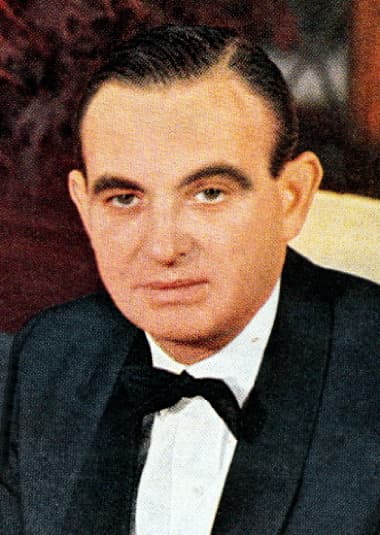
Charles Revson [1906-1975].
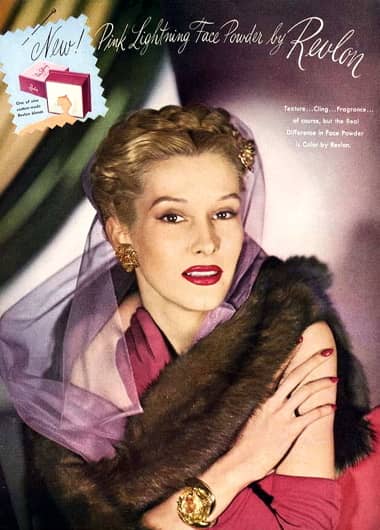
1945 Revlon Pink Lightning Face Powder.
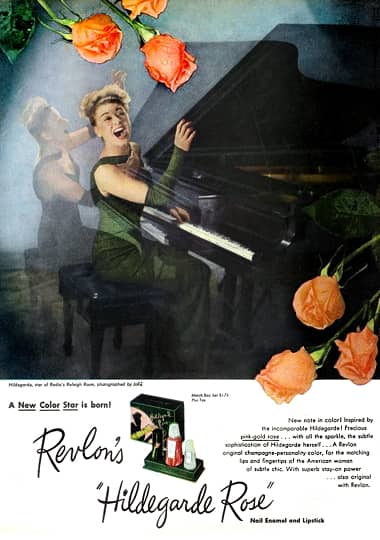
1946 Revlon Hildegarde Rose.
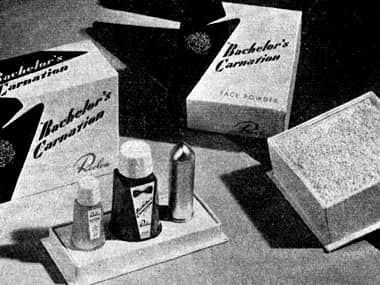
1946 Revlon Bachelor’s Carnation Lipstick, Nail Enamel and Face Powder.
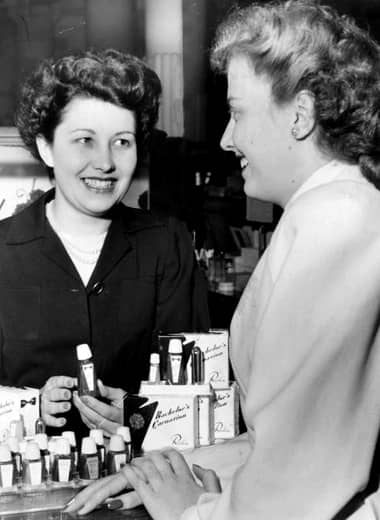
1946 Publicity photograph for Bachelor’s Carnation.
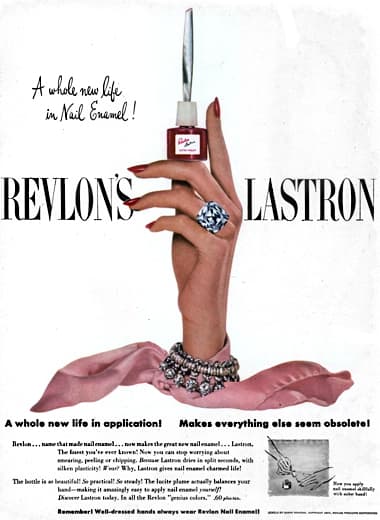
1947 Revlon Lastron.
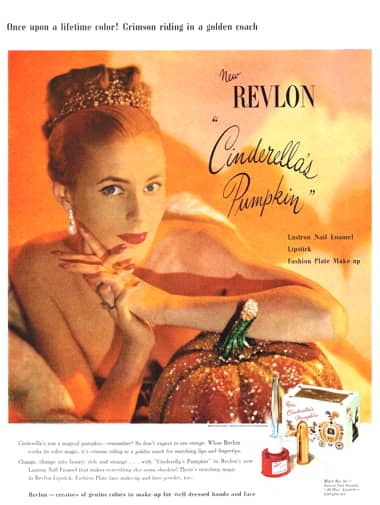
1947 Revlon Cinderella’s Pumpkin.
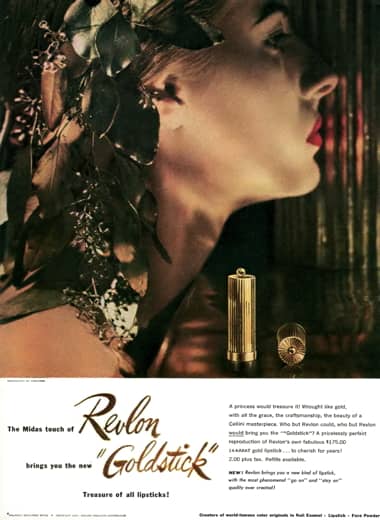
1947 Revlon Goldstick. The lipstick case was a reproduction of a limited edition 24 karat gold case.
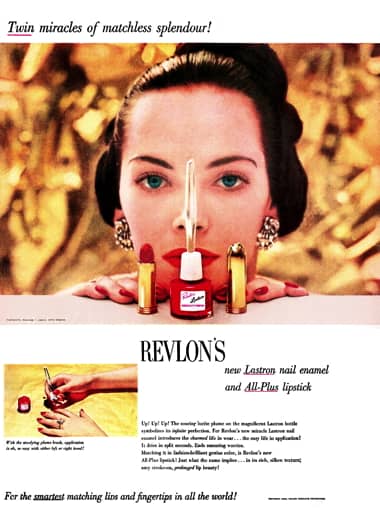
1948 Revlon Lastron Nail Enamel with lucite handle and All-Plus Lipstick in Good-as-Gold containers.
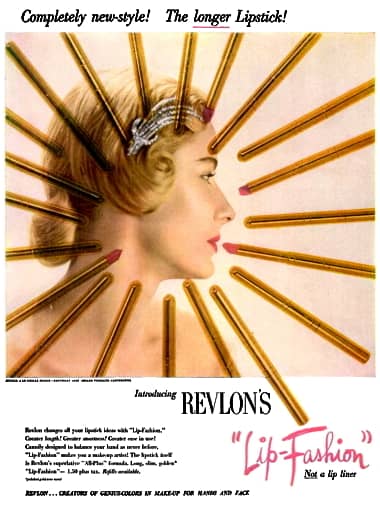
1948 Revlon Lip Fashion.
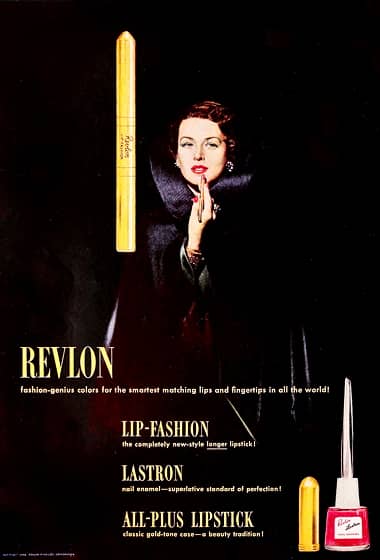
1948 Revlon Nail Enamels and All-Plus and Lip Fashion Lipsticks.
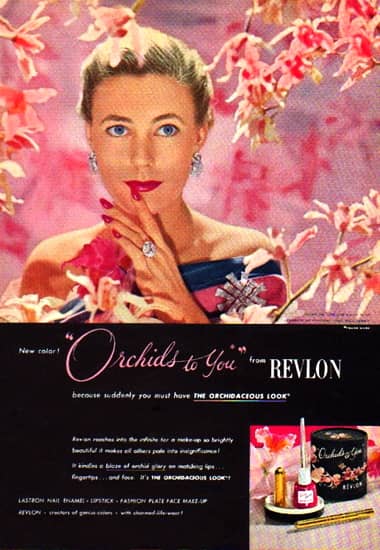
1948 Revlon’s Orchids For You Face Power, Nail Enamel, Regular Lipstick and Lip Fashion.
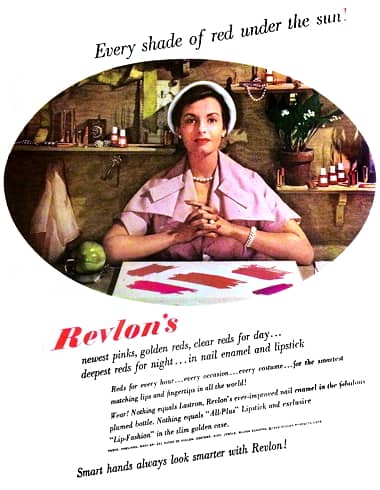
1949 Revlon Nail Enamels and All-Plus and Lip Fashion Lipsticks.
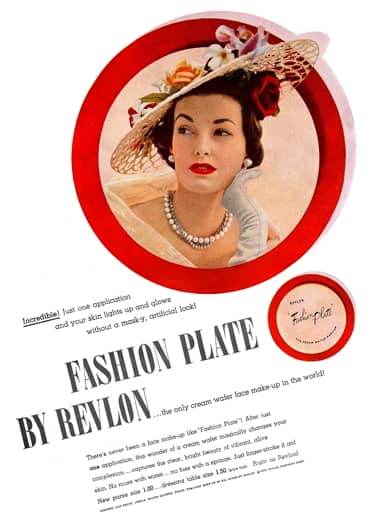
1949 Revlon Fashion Plate pressed-cream make-up. First introduced in 1947 in 11 shades, it was encased in a rose-ivory ‘plate’ rimmed with ruby-red Lucite.
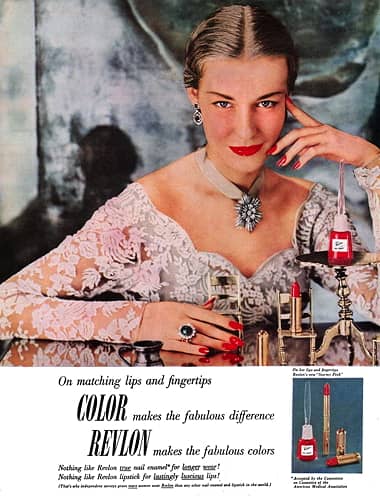
1950 Revlon Stormy Pink in Nail Enamel, Regular Lipstick and Lip Fashion.
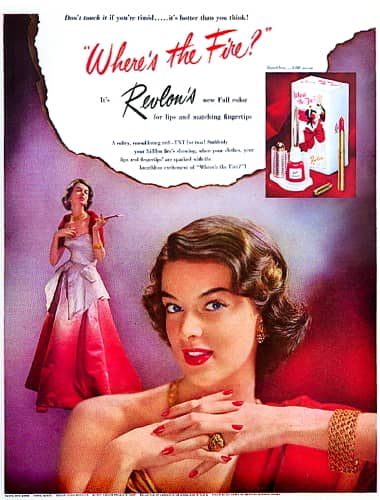
1950 Revlon Where’s the Fire.

1950 Revlon Fashion Plate.
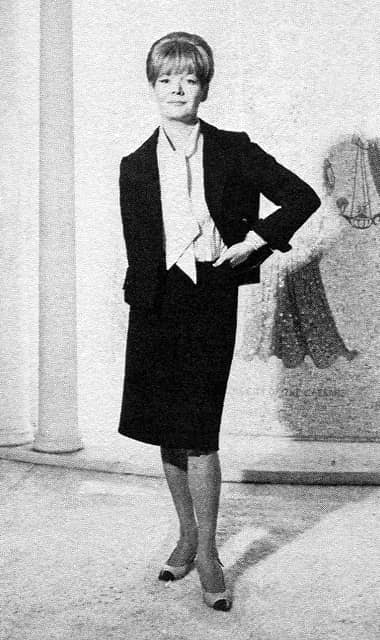
Kathleen ‘Kay’ Daly [1919-1975]

1951 Revlon Aquamarine Lotion, and Aquamarine Lotion Soap.

1951 Revlon Touch-and-Glow Liquid Make-up and Revlon Face Powder. Candles became so strongly associated with Touch-and-Glow that they usually appear in other advertisements for this product.
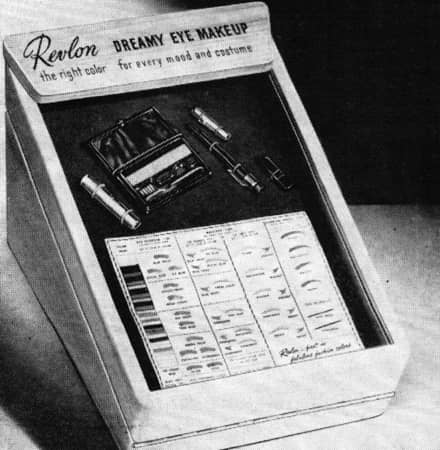
1951 Revlon display stand for Dreamy Eye Make-Up.
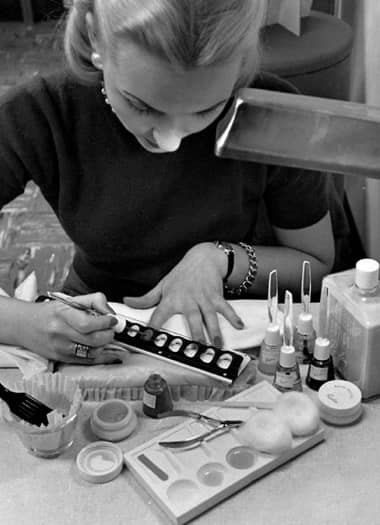
1952 Revlon manicurist using a nail template to enamel her own nails.

1952 Revlon Dreamy Eye Make-Up.
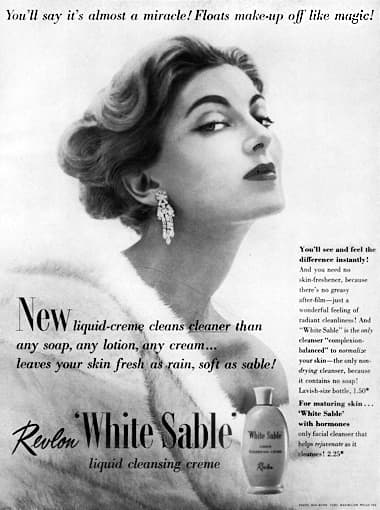
1952 Revlon White Sable.
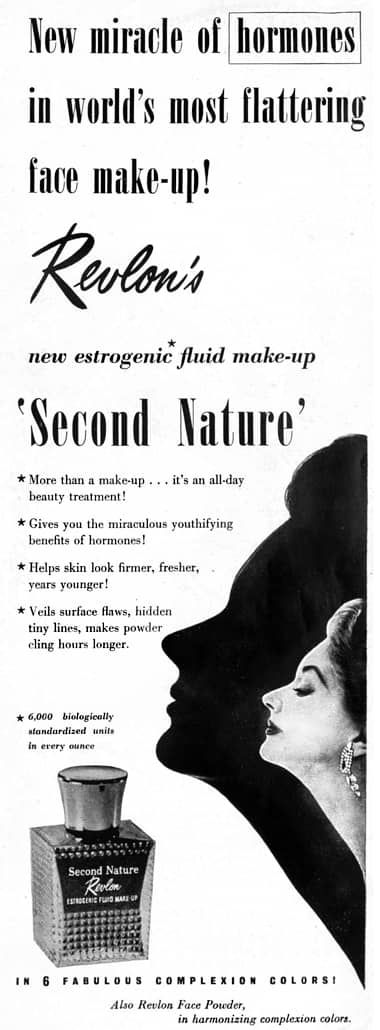
1953 Revlon Second Nature with 6000 IUs of estrogenic hormones.
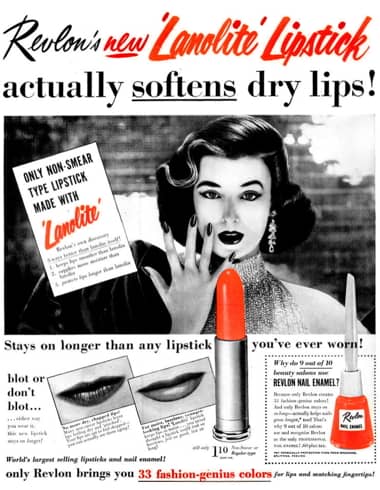
1954 Revlon Lanolite Lipstick.
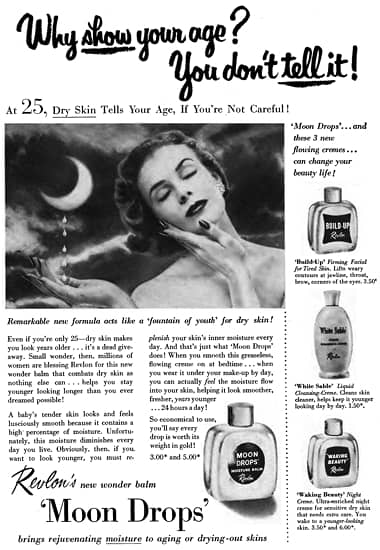
1954 Revlon Moon Drops, Build-Up, White Sable and Waking Beauty.
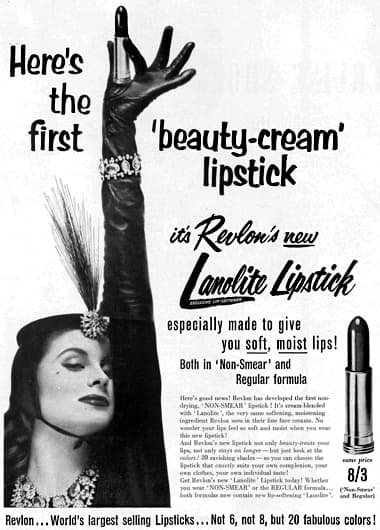
1955 Revlon Lanolite Lipstick (Non-smear and Regular) (Britain).

1955 Left: Living (Love That Pink), Lustrous (Hot Coral) and Lanolite (Cherries a la Mode) Lipsticks. Middle: Engraved White Basketweave, Black Rhinstone Crest, Black Hand-Engraved Silver Floral, and Silver Plated Jeweler’s Bronze Futurama Lipsticks. Right: Frosted Nail Enamel (Pink Platinum), Lastron Nail Enamel (Cherries a la Mode) and Frosted Profile.
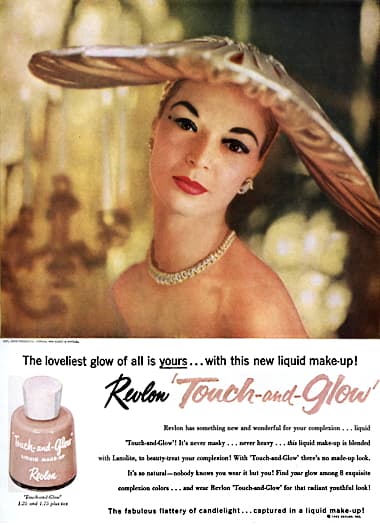
1956 Revlon Touch-and-Glow.
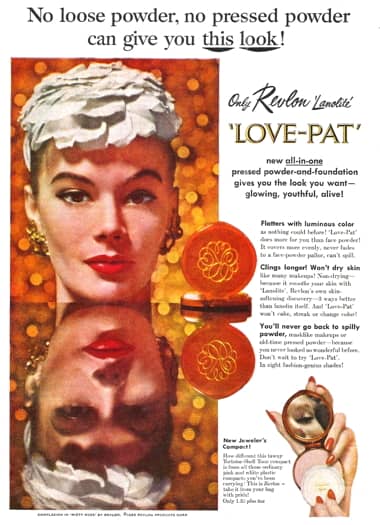
1956 Revlon Love-Pat. Originally released in eight shades: Cream Beige, Cream Ivory, Dark Rachel, Sun Tan, Light, Light Light, Misty Rose, and Rachel.
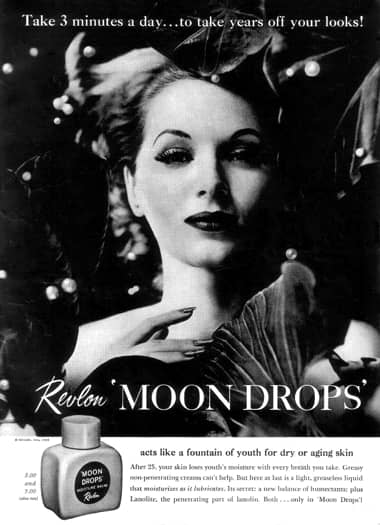
1956 Revlon Moon Drops Moisture Balm. It was considered rather ‘bland’ and was not wildly successful (Woodhead, 2003, p. 344). Revlon added Moon Drops Moisture Foundation in 1958 and later turned Moon Drops into a complete line.

1956 Revlon Clean and Clear.
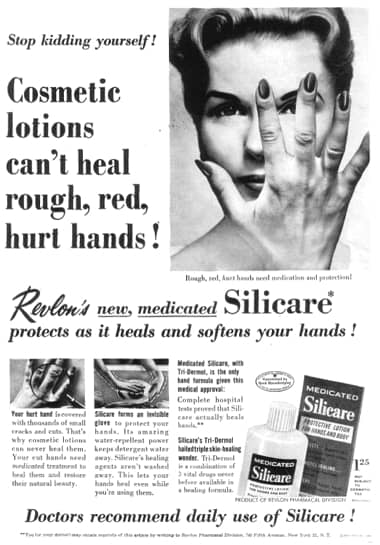
1956 Revlon Silicare medicated hand and body lotion.
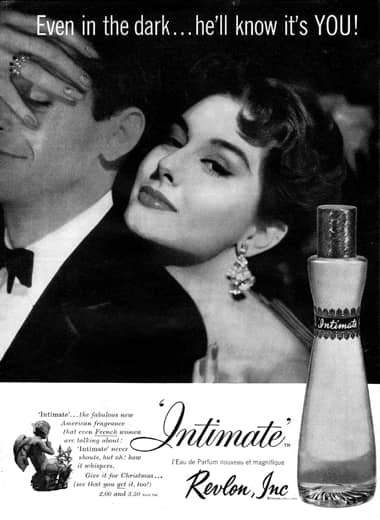
1956 Revlon Intimate parfum.
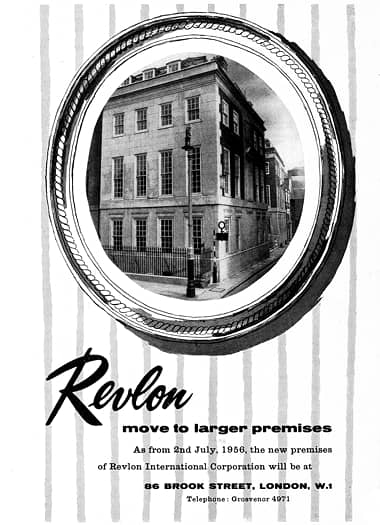
1956 Industry notification of a new London address.
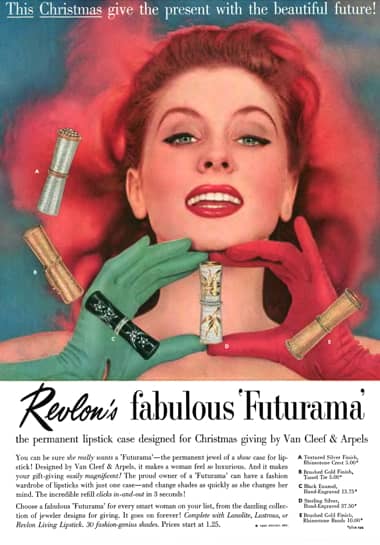
1956 Revlon Futurama lipstick cases. These went on sale in 1955 after Revlon acquired the Braselton lipstick patents for lipstick cartridges in 1954. Revlon then entered into an agreement with Helena Rubinstein and Merle Norman – along with a number of container manufacturers, including Scovill and Risdon – to fix the price of lipstick refills, including non-patented lipstick inserts, until they were charged by the U.S. Federal Trade Commission (FTC) with conspiracy (AP&EOR, 1958).
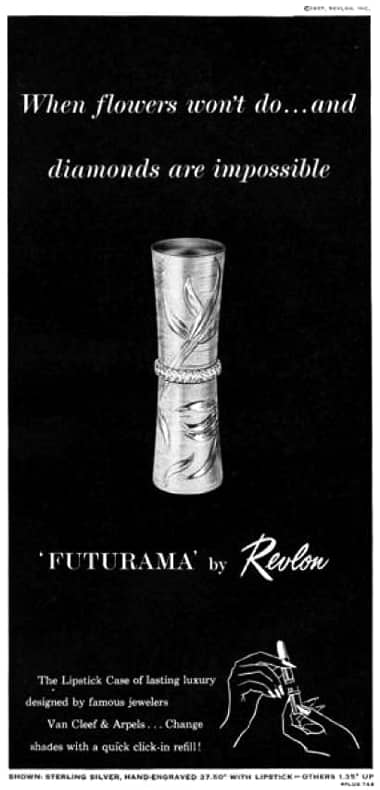
1957 Futurama lipstick cases.
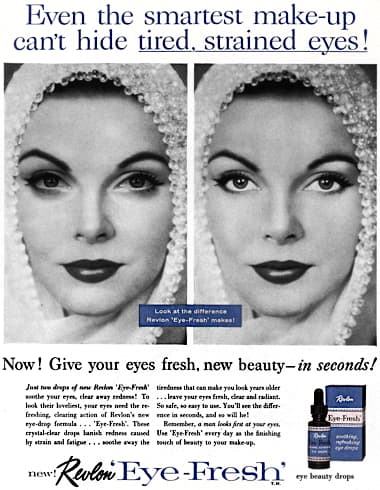
1957 Revlon Eye-Fresh.
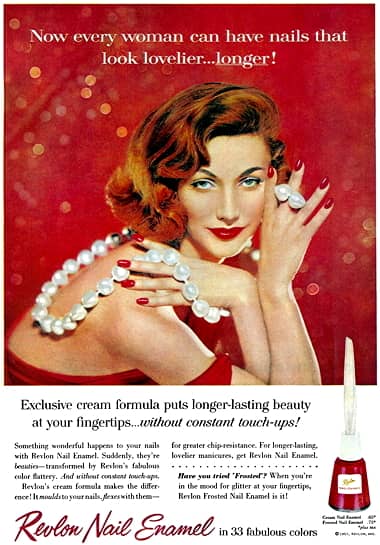
1957 Revlon Nail Enamel.
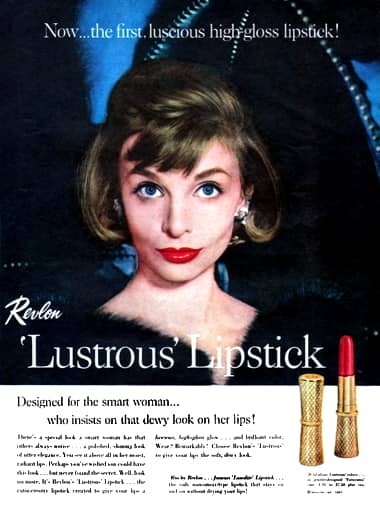
1957 Revlon Lustrous Lipstick in a Futurama case.
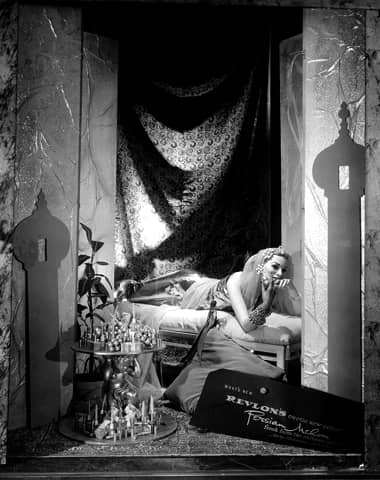
Revlon window display for Persian Melon.
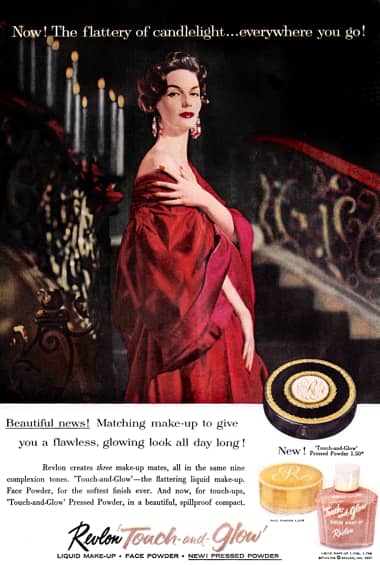
1957 Revlon Touch-and-Glow Liquid Make-up, Face Powder and Compact.
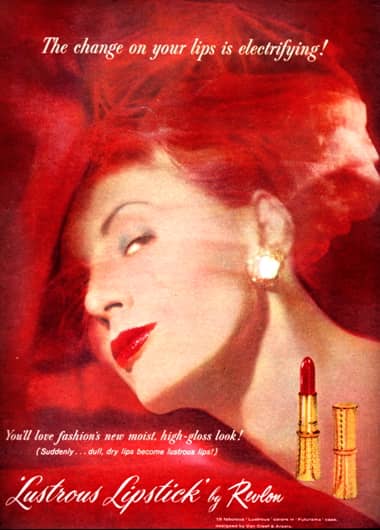
1958 Revlon Lustrous Lipstick.
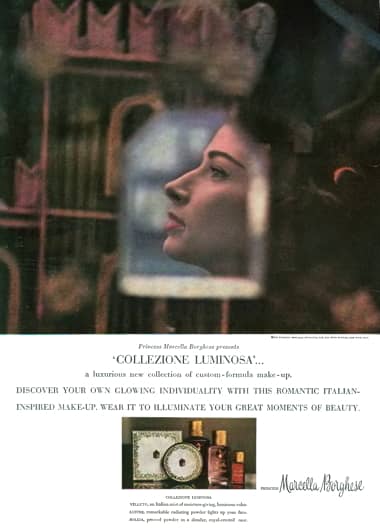
1958 Princess Marcella Borghese. Although the cosmetics may have been ‘Italian inspired’ the recipes came from Revlon’s laboratory.
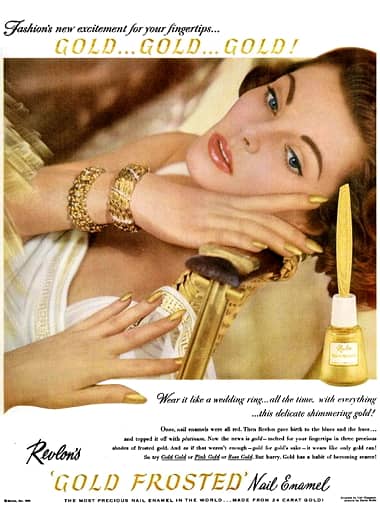
1958 Revlon Gold Frosted Nail Enamel. Revlon introduced Frosted Nail Enamels in 1955 in Platinum, Pink Platinum, Blue-White Platinum and Pink Cloud shades.
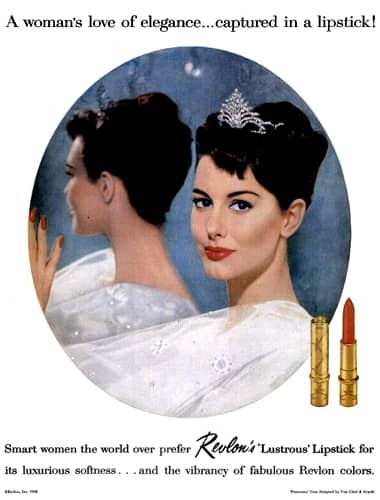
1958 Revlon Lustrous Lipstick.
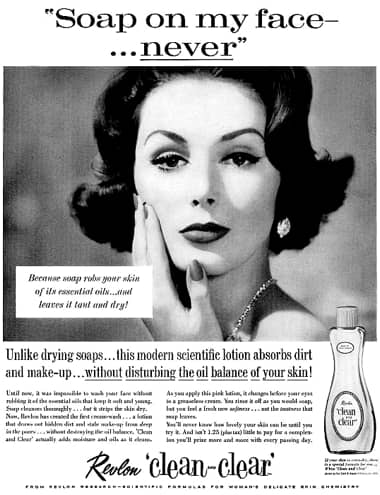
1959 Revlon Clean and Clear.
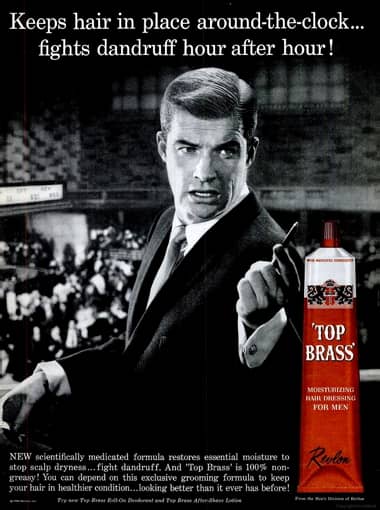
1959 Revlon Top Brass.
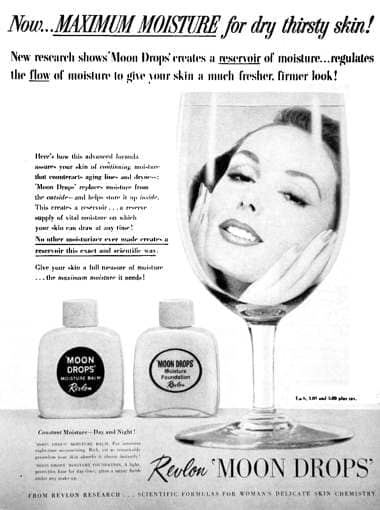
1959 Revlon Moon Drops Moisture Balm and Moisture Foundation.

1959 Princess Marcella Borghese Velluto.
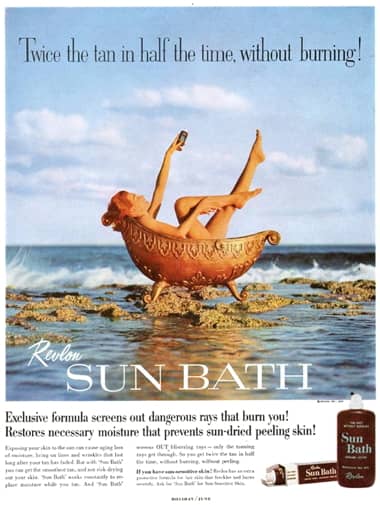
1960 Revlon Sun Bath.
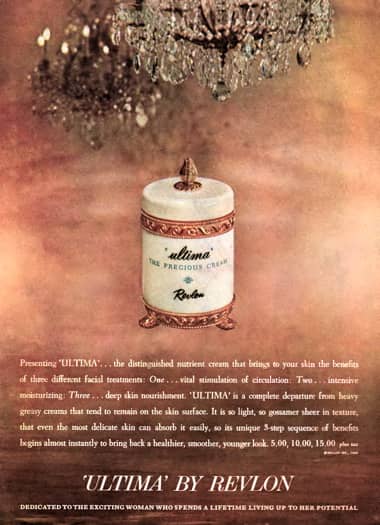
1960 Revlon Ultima in a screw-top glass jar. The packaging was very deceptive. The inner container containing the cream was only as deep as the base of the top gold bar.
